
Tighten girth straps and surcingle on pony and unfurl all the deer straps. If using 2 girth straps, cross them over each other to opposite buckles. If using 3 straps the front and rear ones should be crossed with each other and the centre one tied straight across
Aim
The aim of this guide is to provide information on carcass extraction by pony in order to help ensure the safety of the operators/s and to minimise contamination to the carcass. The BP guide Mechanical and Manual Extraction should be seen as a complementary guide to this subject.
Background
Good for extraction where the ground is too rough for vehicles, or where there is a need to minimise damage to the habitat. Deer extraction using a pony is almost exclusively limited to red deer on Highland estates.
Health & safety
For all extraction activities, ensure the following:
- Carry out appropriate risk assessment*.
- Familiarise yourself with relevant HSE Guidance**.
- Minimise the risk of injury and physical effort — plan and modify the route, e.g. brash routes through trees, mark pony paths.
The Manual Handling Operations Regulations 1992 (as amended) establish clear steps for dealing with risks from manual handling. These are:
- Avoid hazardous manual handling operations (e.g. dragging, lifting, carrying) so far as reasonably practicable;
- Assess any hazardous manual handling operations that cannot be avoided;
- Reduce the risk of injury so far as reasonably practicable.
Pony
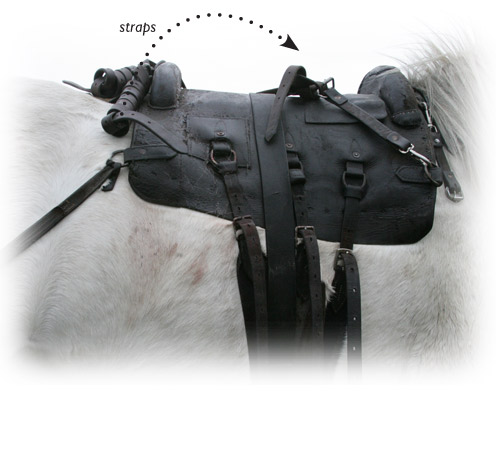
The surcingle should then be passed over the saddle and the centre point of the 3 girth straps. There should be a minimum of 3 deer straps for holding the stag on the saddle. A tail strap, a chest strap and a centre strap with a recommendation of 1 spare strap for each
- Every care should be taken to ensure that the welfare of the pony is taken into account, during and after any extraction activity (e.g. protect the pony from antlers, be vigilant for signs of fatigue or injury, ensure the pony is dried off after wet outings).
- Ensure pony is properly trained.
- Care should be taken to ensure that the saddle fits both correctly and comfortably.
- Deer ponies should be shod both front and back, with the rear shoes having ‘caulkers’ or heal cleats to help in a steep descent.
Handler

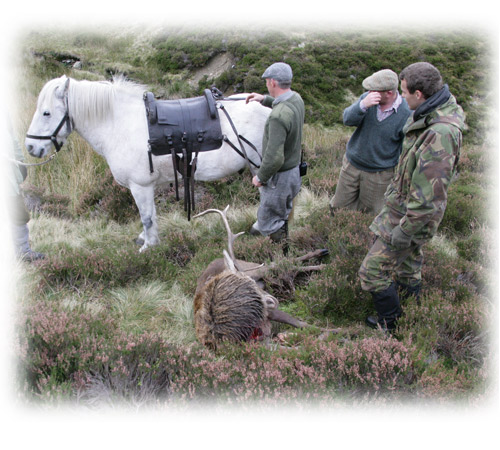
Walk pony round towards stag so that the saddle is level with rear end of carcass on the ponies near (left) side
- Ensure pony handler is trained and confident in all aspects of handling ponies.
- Ensure the handler has been equipped with adequate clothing and equipment for the terrain/weather.
- Ensure effective means of communication with the handler.
- Ensure the handler has been adequately briefed. It will be helpful if the handler is already familiar with the ground/pony paths.
- Minimise risk of injury to pony and handler— plan and modify the route, marking paths through boggy ground and river crossings.
- Carry a knife in case straps/ ropes need to be cut quickly in an emergency.
Equipment
- Stalkers should ensure that all tack used on the pony is kept clean and well maintained, and is regularly checked and repaired as necessary.
It is advisable to carry an extra girth and deer straps.
Loading a Pony
Essentials
- It will require a minimum of two persons to load a pony safely. The pony will also require to be held steady whilst loading.
- Traditionally most ponies are led and loaded from the left side.
- Wherever possible stand the pony on flat ground, well away from steep drops or rocky ground, against a bank or elevated ground to make loading easier.
- Prior to loading the pony re-tightened the girth from the first fitting.
- The load must be securely fastened on the pony’s saddle. Three straps attached to the saddle are used to secure and balance a deer on the saddle. One around the horn (for stags), one around the front left foreleg and chest, and a final strap between the hind legs.
- The load must be balanced: after loading, the pony should be observed from the rear when walking to check that the saddle and load are not swinging about excessively.
- For young or nervous ponies it may be advisable to tie the front and back feet of the carcass together before loading, to prevent them ‘slapping’ the pony while loading and moving. Covering the pony’s eyes whilst loading may also help keep the pony calm.
- When crossing a burn or on unfamiliar ground, let the pony find its own way — it will rarely get into difficulty.
Loading a stag on a pony
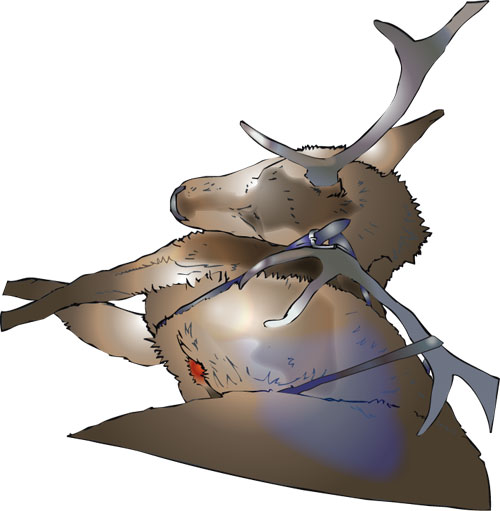
Lie stag on its right side, preferably onto a bank, and pull head onto chest resting horn on ribcage
- Lie stag on its right side, preferably onto a bank, and pull head onto chest resting horn on ribcage. Using belt or rope tie head down by sliding rope/belt under carcass, and just over coronet of right hand antler. Pass one end of rope through looped end, pull head down onto chest and tie off. The buckle strap or loop must be towards brisket so you are pulling the nose of the stag down into the chest. Lift back left leg up and pull towards head so that left hand antler is trapped in between stags legs.
- Tighten girth straps and surcingle on pony and unfurl all the deer straps. If using 2 girth straps, cross them over each other to opposite buckles. If using 3 straps the front and rear ones should be crossed with each other and the centre one tied straight across. The surcingle should then be passed over the saddle and the centre point of the 3 girth straps. There should be a minimum of 3 deer straps for holding the stag on the saddle. A tail strap, a chest strap and a centre strap with a recommendation of 1 spare strap for each.
- Walk pony round towards stag so that the saddle is level with rear end of carcass on the ponies near (left) side.
- Using a minimum of two people, one at the head and 1/2 at the rear end, lift the stag, place the rear end onto the saddle and slide the stag over the saddle until the head is level with the top deer strap ring.

chest strap comes from the rear of the saddle to tie between front legs
- With someone holding the stag, fasten the tail strap first followed by the chest strap and finally the chest strap. To do this:-
Move round to rear end of stag and lift left rear leg up and release trapped antler. Pass tail strap up through between legs and above tail and tie off through the buckle strap at front end using your shoulder against stag’s rear end to push up stag as you are tightening strap.
Move round to front end of stag. Pass chest strap across chest of stag keeping strap above and over legs and tie off through buckle strap at front end.
Finally wrap centre strap round the antler once before fastening.
When the stag is fully tightened the rear legs should be pulled forward so that they are pointing to the ground rather than to the rear to stop the carcass flapping when the pony is walking. - The aim is to ensure the stag is tied on properly and is balanced on the saddle so that when the pony is walking, the movement will not cause the stag to start slipping down the saddle. When correctly balanced, the stag should look as if it’s tail end is hanging down.
- Stand behind the pony and check the stag looks balanced on the saddle before and after the pony moves off. If the stag starts slipping its likely to be in the first 200-300 yards.
- Continually check the stag is still positioned properly on saddle. Any sign of slippage, stop pony and readjust by either tightening up slackened straps or slackening off appropriate straps and pulling or pushing stag back to proper position before tightening straps again.
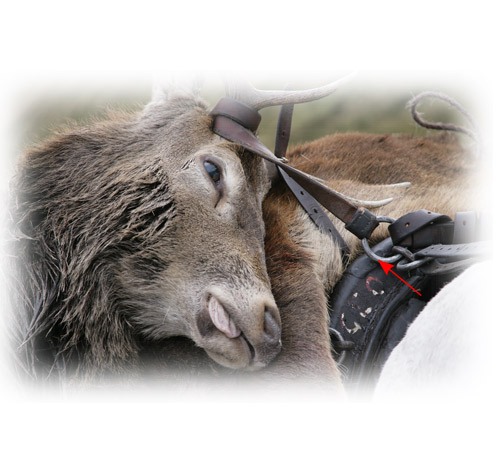
centre strap wrapped around antler
- When unloading stag from pony, undo deer straps at front end and then rear end of stag. Holding stags head, undo top deer strap and make sure all straps are visibly clear. Standing on near (left) side of pony, pull stag off saddle by the head and carefully guide stag onto ground, making sure the carcass keeps clear of the pony. If possible use 2 people when unloading.
- Before moving pony off, the girth straps must be slackened off as the saddle will tighten up with no load on it. Finally, tie up all deer straps on saddle.
- For Hummels or young stags with no horns, load as if you were loading a hind.
Loading a single hind or calf on a pony
chest strap comes from the rear of the saddle to tie between front legs
1. Position the pony near the hind or calf as for loading a stag. Using a minimum of two people, one at the head and one at the rear end, lift the carcass, rear end first, and slide over the saddle.
2. Hold in position until the centre strap is loosely tightened to keep hind on the saddle. Position hind so that it lies balanced on saddle with head hanging.
3. Pass tail strap up through between legs and above tail and tie off through the buckle strap at front end using your shoulder against hind’s rear end to push up hind as you are tightening strap.
4. Move round to front end of hind. Pass chest strap across the neck at top of shoulder and between both legs with head hanging down.
5. Pull the hinds rear legs forward until legs are pointing down rather than back so carcass will not be flapping on saddle when pony is walking.
6. Adjust and tighten centre strap over middle of hind.
Loading two hind or calf carcasses on a pony
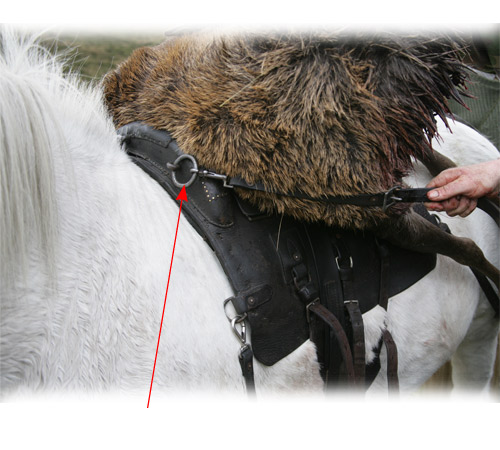
tail strap comes from the back of the saddle, through the hind legs of deer and fastens to buckle on front of saddle
1. To load two carcasses, lift the first carcass tail first and lie on the front of the saddle with legs facing towards rear of pony. If necessary, secure temporarily with the centre strap.
2. Lift the second carcass on head first at back of saddle with legs facing forward so that the carcasses are top to toe facing each other. Using the centre strap pull the carcasses together making sure their chests are jammed together.
3. Use straps the same way as with one carcass but catching both carcasses.
Loading three hind/calf carcasses on a pony
1. It is not advisable to load three large hinds on one pony. If you need to load three, try not exceed a maximum load of two average weight hinds and one calf.
2. Load the heaviest of the carcasses haunch first onto the front of the saddle with the legs facing to the back of the pony. Load the second heaviest carcass, also haunch first, at the back of the saddle with the legs facing towards the front of the pony.
3. Load the smallest carcass head first, between the other two carcasses. Pull all the carcasses together, so that the chest of the middle carcass lies in the hollow space created by the other two carcasses.
4. Use straps the same way as before but if strap doesn’t reach or is sitting too high, then make sure strap is is over the shoulders and sitting between the legs of all beasts.
